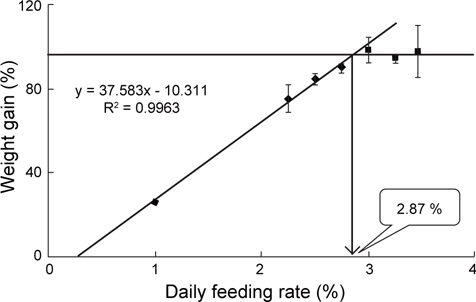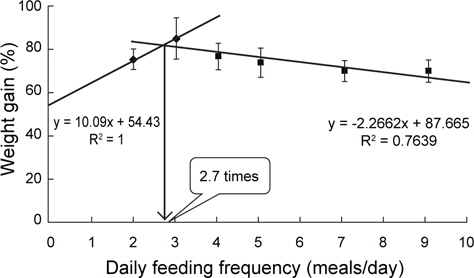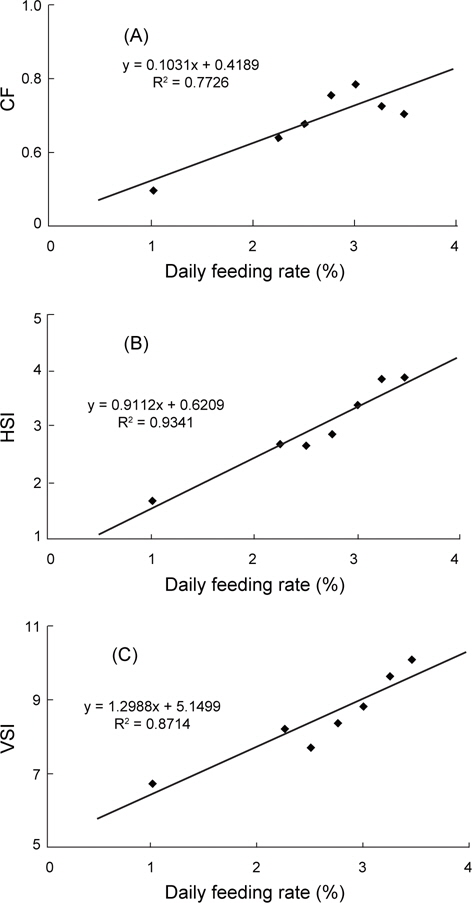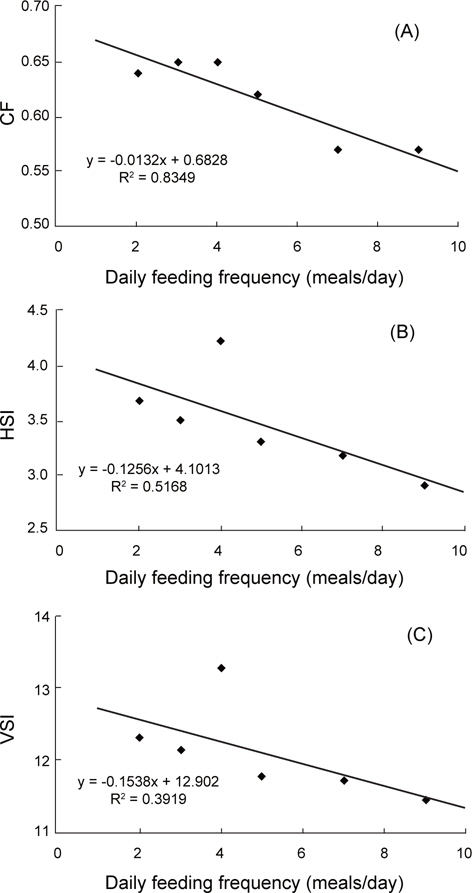



Two feeding trials were conducted to investigate the effects of feeding rate and frequency on growth performance and body composition of juvenile Korean rockfish
우리나라 주요 어류양식 어종인 조피볼락(
배합사료의 적정 공급률과 공급횟수는 대상 어종마다 다르며, 어류의 성장단계와 사육환경에 영향을 받는다(Ng et al., 2000; Mihelakakis et al., 2002). 하지만 사육환경 조건에 따라 어류의 사료섭취량에 직접적으로 영향을 미칠 수 있기 때문에(Brett and Higgs, 1970), 대상 어종에 대한 배합사료 공급체계가 확립되지 않을 경우 배합사료가 부족 또는 과잉으로 공급되기 쉽다 (Lee et al., 2000a). 배합사료가 과잉으로 공급될 경우 사료유실로 인한 경제적 손실과 수질오염이 발생 할 수 있으며, 사료가 부족하게 공급될 경우 어체내 필요한 영양소 요구량을 만족시키지 못하게 되어 어류성장을 저해 할 수 있다. 따라서 양식경영비의 높은 비중을 차지하는 배합사료의 공급체계 확립은 어류의 양식경영을 효율적으로 관리할 수 있게 할 것이며, 어류의 성장 및 사료효율 증가로 경제적인 이익뿐만 아니라 사료 과잉 공급 시 발생하는 사료유실을 최소화하여 양식배출수로 인한 환경오염을 저감 시킬 수 있을 것이다.
조피볼락 양식은 대부분 해상가두리에서 이루어지며 연근해지역의 수온변화에 영향을 받는다. 현재까지 조피볼락에 대한 배합사료 공급체계가 확립되어 있지 않으며, 양식생산성 극대화와 환경친화적인 측면에서 수온변화에 따른 적정 사료공급 량 및 공급횟수에 대한 가이드라인이 필요하다. 따라서, 본 연구는 조피볼락 치어에서 배합사료의 적정 공급률과 공급횟수가15℃ 수온에서 어체 성장 및 체조성에 미치는 영향 조사하기 위해서 수행되었으며, 조피볼락 배합사료 공급방법에 대한 기초가이드라인 확립을 위해서 수행되었다.
실험어는 전북 고창에서 운반된 조피볼락 치어를 부경대학교 영양대사학 실험실내 400 L수조에서 실험환경에 적응할 수 있도록 2주간 예비사육 하였다. 예비 사육 후, 본 실험에서는 배합사료 적정 공급률과 공급 횟수에 대한 2개의 사료공급 실험을 수행하였다. 적정 공급률 실험(실험 1)은 평균무게2.09±0.03 g인 치어를 36 L 사각수조에 각 실험구 당 20마리씩 3반복으로 무작위 배치하였다. 적정 공급횟수(실험 2) 실험은 평균무게 2.04±0.03 g인 치어를 36 L 사각수조에 각 실험구 당 20마리씩 3반복으로 무작위 배치하였다. 실험1과 2의 사료공급 실험환경은 동일하였으며, 각 실험수조는 반 순환여과 시스템에서 유수량은 2 L/min로 조절하였다. 충분한 산소 공급을 위해 에어스톤을 설치하였으며, 전 실험기간 동안 평균수온은 15.0±0.4℃, 염분은 33±1 psu, 용존산소는 7.8±0.5 mL/L, pH는 7.4±0.5으로 유지하였다. 각 실험1과 2의 사육실험은 총 4주간 진행하였다.
실험 1에 사용된 실험사료는 조피볼락 치어의 상업용 배합사료(수협, 침강 2호S)이고 일반성분 조성은 수분 8.89%, 조단백질 47.21%, 조지방 9.22%, 조회분 14.45%로 나왔으며, 총에너지 4526, 사료 크기 2.4-2.6 mm인 사료를 사용하였다. 일일사료 공급량은 어체 무게당 1.00%, 2.25%, 2.5%, 2.75%, 3%, 3.25% 및 만복공급(SA)으로 총 7개 실험구를 두었고, 1일 3회 (08:00, 14:00, 20:00h)에 나누어 공급하였다. 실험2에 사용된 실험사료는 실험 1과 동일한 사료로 수행되었다. 사료공급량은 실험 1의 적정 공급률 결과를 바탕으로 어체중의 2.87%를 제한 공급 하였으며, 공급횟수는 1일 2회(08:00, 20:00h), 3회(08:00, 14:00, 20:00h), 4회(08:00, 12:00, 16:00, 20:00h), 5회(08:00, 11:00, 14:00, 17:00, 20:00h), 7회(08:00, 10:00, 12:00, 14:00, 16:00, 18:00, 20:00h), 9회(08:00, 9:30, 11:00, 12:30, 14:00, 15:30, 17:00, 18:30, 20:00h)로 총 7개의 실험구를 설정하여 실험어에게 동일한 양으로 나누어 공급하였다.
어체 측정 항목과 방법은 실험 1과 2에서 동일하였으며, 2주에 한번 중간 측정하였다. 성장률을 측정하기 위하여 24시간 절 식시킨 후 MS-222 (100 ppm)로 마취시켜 전체무게를 측정하였다. 실험 종료 후 증체율(Weight gain, WG), 사료효율(Feed efficiency, FE), 일간성장율(Specific growth rate, SGR), 단백질전환효율(Protein efficiency ratio, PER), 생존율(Survival)을 측정 하였으며, 실험 구당 15마리씩(5 fish×3 replicates) 무작위 선택하여 비만도(Condition factor, CF), 간 중량지수(Hepatosomatic index, HSI), 내장 중량지수(Viscerosomatic index, VSI)를 측정하였다.
각 수조에서 5마리씩 무작위로 추출하여 분쇄한 전어체를 사용하였으며, AOAC (AOAC, 2000) 방법에 따라 수분은 상압 가열건조법(135℃, 2시간), 조단백질은 Kjeldahl 질소정량법 (N×6.25), 조회분은 직접회화법으로 분석하였다. 조지방은 샘플은 12시간 동결 건조한 후, Soxhlet 추출법으로 분석하였다 (Soxtec system 1046, Tacator AB, Sweden).
모든 자료의 통계처리는 J.M.P program version 9.1.3 statistical software (SAS Institute, 2004)를 이용하여 One-way ANOVA test를 실시한 후, 최소 유의차 검정(LSD: Least Significant Difference)을 실시하여 평균간의 유의성(
저수온기에 조피볼락 치어를 대상으로 4주간의 적정 사료공급률 실험결과 전 실험구에서 100%의 생존율을 보였다(Table 1). 적정 공급률 실험에 대한 성장결과는 Table 1에 나타내었다. 증체율과 일간성장율은 3.00%와 만복구 그룹에서 2.75%, 3.25% 실험구와 차이를 보이지 않았으나(
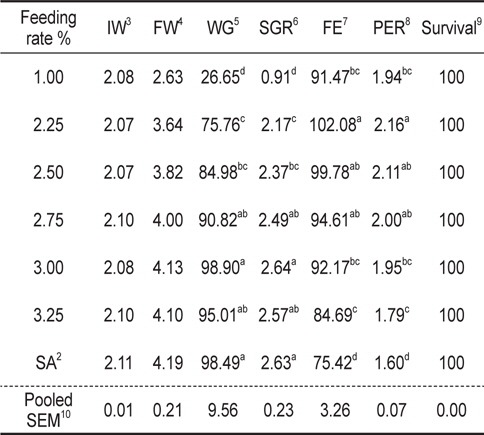
Growth performance of juvenile Korean rockfish Sebastes schlegeli fed a commercial diet for 4 weeks1 (Exp. 1)
사료효율과 단백질전환효율은 2.25% 실험구가 2.50%, 2.75% 실험구는 유의한 차이가 없었지만(
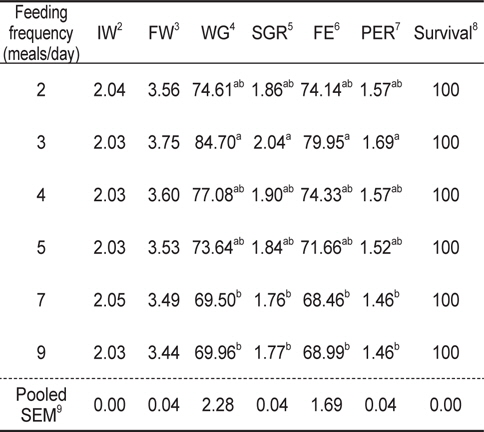
Growth performance of juvenile Korean rockfish Sebastes schlegeli fed a commercial diet for 4 weeks1 (Exp. 2)
전어체 일반성분 분석결과는 Table 3에 나타내었다. 수분함량은 1.00% 실험구가 2.50%, 2.75%, 3.00%에 비해 유의하게 높게 나타났으며(
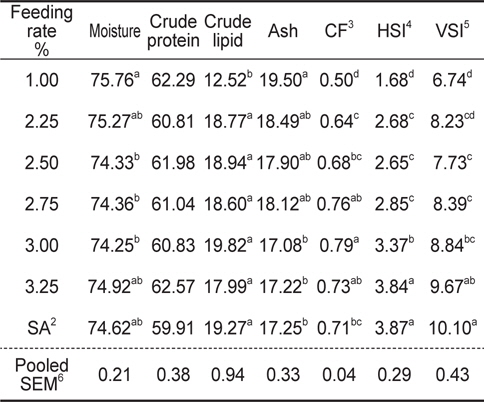
Whole body proximate composition and biological indices of juvenile Korean rockfish Sebastes schlegeli fed a commercial diet for 4 weeks1 (Exp. 1)
조피볼락 치어를 대상으로 4주간의 사료 공급횟수 실험기간동안 모든 실험구에서 100%의 생존율을 보였다(Table 2). 사료 공급횟수 실험에 대한 성장결과는 Table 2에 나타내었다. 모든 성장관련 결과에서 유사한 경향을 나타내었다. 증체율, 일간성장율, 사료효율과 단백질전환효율에서 3회 실험구가 2회, 4회, 5회와는 유의한 차이를 보이지 않았으며(
전어체 일반성분 분석결과는 Table 4에 나타내었다. 일반성분 분석결과 전 실험 구에서 유의한 차이를 보이지 않았지만 (
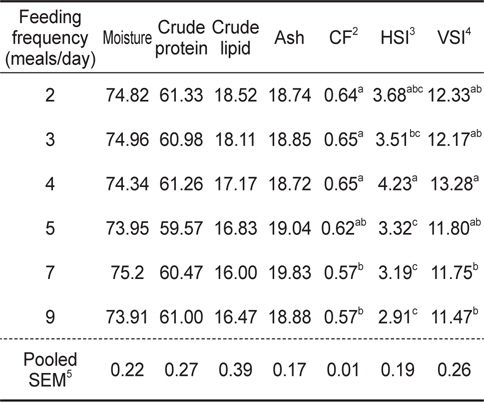
Whole-Body proximate composition and biological indices of juvenile Korean rockfish Sebastes schlegeli fed a commercial diet for 4 weeks1 (Exp. 2)
이전 조피볼락 연구에서는 본 연구와 달리 Myeong et al. (1997)의 연구에서는 육상수조양식장에서 1년생 조피볼락의 적정 공급률이 만복공급의 70-80%라고 보고 되었고, 평균체중 25-60 g 크기의 조피볼락 적정사료공급횟수는 2일 1회이며, 6-20 g 크기에서는 1일 1회라고 보고하였다(Lee et al., 1996; Lee et al., 2000b). 이러한 결과들은 적정 사료공급률과 공급 횟수가 어종, 성장단계, 수온, 사료내 영양소 종류와 함량 및 사육조건 등에 의해서 영향을 받는다는 것으로 보고되었으며(Wang et al., 1998; Lambert et al., 2001; Dwyer et al., 2002; Riche et al ., 2004), 체중에 대한 백분율로 나타낸 적정 사료공급률은 어체크기가 증가할수록 감소하고, 수온이 높아지면 증가하는 것으로 보고되었다(Brett, 1979). 어류는 변온동물로, 수온이 낮을수록 소화효소의 활성 및 대사율이 감소하지만, 반대로 사료 공급률이 같을 경우 수온이 상승함에 따라, 소화효소의 활성 및 대사가 증가되어 체내에 축적된 지방의 이용성을 증대시킬 수 있다고 보고되었고(Fange and Grove, 1979; Fauconneau et al., 1983), Kim et al. (2011) 의 연구에서는 고수온기에 비해 저수온기에서 어체내 지방함량이 높게 나타나는 경향을 보였다. 향후 조피볼락의 사료 공급체계의 확립을 위해서는 사료공급률을 다르게 하였을 때의 사료 적정 공급횟수, 성장단계별 또는 적수온과 고수온기에 적정 사료공급률과 공급횟수에 대한 연구가 수행되어야 할 것이다.
본 연구를 통한 조피볼락 치어의 최적성장을 위한 상업용 배합사료의 적정 공급률과 공급횟수는 증체율을 바탕으로 한 broken line analysis로 분석한 결과 적정 공급률은2.9% 이상3% 미만이며 적정 공급횟수는 증체율을 바탕으로 second-order polynomial analysis로 분석한 결과 1일 2회에서 3회를 공급하는 것이 적정 수준인 것으로 나타났다.



